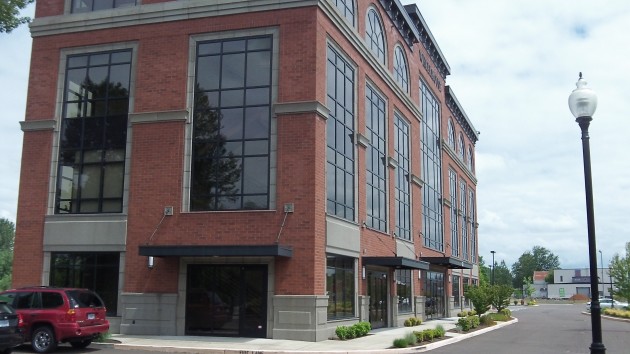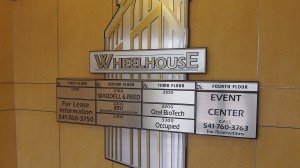CARA, Albany’s downtown urban renewal district, will hold a public open house Wednesday (June 4) to collect suggestions on which “public infrastructure” projects it should pursue. But hanging over the agency now is the proposal to use its funding to help pay for the central fire station and expansion of the police headquarters. Tempting though that idea seems, it runs counter to the purpose of economic revival on which the agency is based.
The open house will be at the Wheelhouse, the privately funded riverside office building that also got some support from CARA. The CARA board has proposed to use about $3 million from its latest round of borrowing for street or utility projects in which there is some hope they would encourage more private investment. They’re talking about improvements along Water Avenue and Main Street, among other things, and even on the Dave Clark Path, but it’s hard to see any blockbuster private developments resulting from those.
Proponents of using CARA to fund the police and fire stations point out this would lessen the burden of a big bond issue on property owners. In their eyes it would also divert a big chunk of CARA funds to a cause far sounder than some of the other proposals.
Could it be done? Our faithful reader Gordon Shadle said the other day, in a letter to the local paper, that the CARA plan authorizes spending on public facilities, a term that should cover the police and fire stations, so no change in the plan would be necessary.
Here’s what the 2002 CARA plan actually authorizes in terms of projects listed under the heading of “public facilities.” It describes them this way: “Establish and enhance facilities such as libraries, museums, performance areas, parks and the arts.” All the examples are places the public can use and presumably enjoy, places that would attract people downtown in the cause of economic revival. The police and fire stations do not meet that test. They are not open to the public. They are not potential attractions that bring in visitors. They are owned by the public the way the sewer plant is owned by the public, but they are not “public facilities” in the context of the CARA plan.
There’s another aspect: CARA takes property taxes collected on new value that would otherwise go to the regular taxing districts including the county. In theory, they will get reimbursed from tax revenue on all the value that CARA manages to add to the district once it is dissolved, which the plan estimates will happen in 2027. By then, the plan estimates Linn County will have forgone $11 million in taxes, the city of Albany twice that much and the schools $15.8 million. The amounts are smaller for other taxing districts.
Do those other units have a responsibility to help Albany build fire and police stations with urban renewal taxes without any hope of getting the money back because the stations are tax-exempt?
The CARA program, more than a dozen years old now, has yet to hit its stride. Its success has been substantial but far below the expectation when it was begun. It was intended to carry out the Town Center Plan to keep the core of the city from dying. It was also intended to renew the large area east of Lyon Street, where blight was widespread. A start has been made, even though it’s been far slower than it should have been. We, meaning the whole community, should demand that this program get going on the big things it was supposed to accomplish. Let’s not sidetrack it with projects it was not meant to do. (hh)



You need to go back and re-read the CARA Plan. In the quote you provided the phrase “such as” is meant to be illustrative, meaning “for example.” The phrase is not restrictive, nor does it create any kind of special “test” (your word).
You missed the Burright/Morse committee meeting where lawyer Jeannette Launer addressed the issue of using urban renewal funds to build public safety facilities –
“It’s a policy choice where you put your tax increment financing funds.”
It all boils down to priorities.
It is totally disingenuous to suggest that the purposes in founding CARA were anything other than economic development and physical revitalization of decaying parts of Albany.
Gordon Shadle, in his now-familiar “Sea Lawyer” approach to dragging whatever tortured logic out of clear language he can to prevent CARA from staying focused on economic revitalization, is just wrong. It is nothing more than a continuation of his efforts to stop any economic redevelopment as has been his focus for about a decade now. It is nothing more that an extension of his efforts to prevent the community from using the lawful powers of city government to make their lives better.
The police and fire facilities have exceeded their useful lives and that is clear to the entire community. It is the responsibility of the entire community to take responsibility and solve the problem. The costs are modest since an expiring existing tax charge could have funded the vast portion of the cost.
National, state, and local economies are finally starting to really grow again, after a long and hard recession. In this spring awakening, gardeners know that applying minerals and sustenance to new shoots result in a bountiful harvest later. It is that kind of forward thinking, planning and action that CARA provides to the economic bounty the citizens seek to harvest.
This is not the time to strangle CARA as Shadle and others seek to do. This is the time to redouble investment efforts to build the future.
Funding the total cost of the public building (police/fire) with UR money will not strangle anything. The CARA plan was made to be modified if that’s needed. The current plan has no date-certain expiration date and that was intentional. The current plan plainly encourages investment in public buildings and has been used many times for that purpose over the 13years since the plan was adopted.
I challenge the earlier writer to give facts to support the idea that “CARA has provided an economic bounty for the citizens to harvest”. The fact is that the UR district has not come close to the increased property valuation of the rest of the city even after millions have been spent with no potential to recover the “investment” by CARA. Hasso should look at the data-not just repeat the hype. Look at the money spent already on public projects with no recovery intended–e.g.80% of the $1/2 million sidewalk-to-nowhere was
infrastructure. Look at all the data!
Replacing the Fire/police buildings using TIF money is the best use of available funding w/o increasing taxes at all. Doing that will not sidetrack any other work to be done. The zero sum game being espoused by Hasso is a false argument
From the Linn County Assessor Tax Summary available on the Linn County web site:
2002 – 2003 Albany Tax Assessed (less Urban Renewal) $12,827,786
2013 – 2014 Albany Tax Assessed (less Urban Renewal) $20,530,412
Increase:160%
2002 – 2003 Albany Urban Renewal Tax Assessed $322,247
2013 – 2014 Albany Urban Renewal Tax Assessed: $2,071,213
Increase: 643%
I note you provided NO evidence for your statement Tom. You owe folks an apology.
Here are the facts. Mr. Woods is really quoting numbers w/o meaning.
He uses a percentage based on changes to the tax assessed; which is NOT the same as changes in taxable valuation. Remember the cara mantra that investment from taxpayers will increase the taxable valuation of properties.
Now the data:
The frozen taxable value of all property in the cara district in 2001 was $243M. The base line for all these calcs is july 1st 2002 and the taxable value of cara properties then was $265M.
On July 1st 2013 those properties had increased taxable value from the $265M to $379M.which is a $114M increase. BUT remember Measure 50 provides for an
automatic 3%/yr increase which accounts for $102M of the increase; so the URD actually had only $12/$265= 4.5% increase in taxable valuation over 10 years. after spending $10M cara money from taxpayers.
Now the whole City in both Counties excluding all properties within the cara district.
In base year 2002, taxable value was $1844M. By 2013 that value had increased to
$3084M. So an increase of $1240M but Measure 50 was responsible for $829M of that so the rest of the City had $411M/$1844M= 22% increase in taxable valuation after 10 years w/o any URD “investment”.
So the private sector increases the taxable valuation rate nearly 5 Times faster than the URD system has done over 10 years.
All the numbers come from County documents SAL,Table 4E and SATR p.2&5. They have been vetted by Mark Noakes recently retired Linn County Assessor.
I won’t ask for an apology. I’ll settle for a willingness to accept the truth